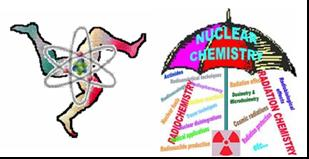Speaker
Constantin Papastefanou
(Aristotle University of Thessaloniki, Department of Physics, Atomic and Nuclear Physics Laboratory)
Description
The aerodynamic size distributions of radon decay product aerosols, i.e. 214Pb, 212Pb, and 210Pb were measured using low-pressure (LPI) as well as conventional low-volume 1-ACFM and high-volume (HVI) cascade impactors. The activity size distribution of 214Pb and 212Pb was largely associated with submicron aerosols in the accumulation mode (0.08 to 2.0 μm). The activity median aerodynamic diameter “AMAD” varied from 0.10 to 0.37 μm (average 0.16 μm) for 214Pb-aerosols and from 0.07 to 0.25 μm (average 0.12 μm) for 212Pb-aerosols. The geometric standard deviation, σg averaged 2.86 and 2.97, respectively. The AMAD of 210Pb-aerosols varied from 0.28 to 0.49 μm (average 0.37 μm) and the geometric standard deviation, σg varied from 1.6 to 2.1 (average 1.9). The activity size distribution of 214Pb-aerosols showed a small shift to larger particle sizes relative to 212Pb-aerosols. The larger median size of 214Pb-aerosols was attributed to α-recoil depletion of smaller aerosol particles following the decay of the aerosol-associated 218Po. Subsequent 214Pb condensation on all aerosol particles effectively enriches larger-sized aerosols. 212Pb does not undergo this recoil-driven redistribution. Even considering recoil following 214Po α-decay, the average 210Pb-labeled aerosol grows by a factor of two during its atmospheric lifetime. Early morning and afternoon measurements indicated that similar size associations of 214Pb occur, despite humidity differences and the potential for fresh particle production in the afternoon. In estimating lifetimes of radon decay product aerosols in ambient air, a mean residence time of about 8 days could be applied to aerosol particles in the lower atmosphere below precipitation cloud levels.
Author
Constantin Papastefanou
(Aristotle University of Thessaloniki, Department of Physics, Atomic and Nuclear Physics Laboratory)
